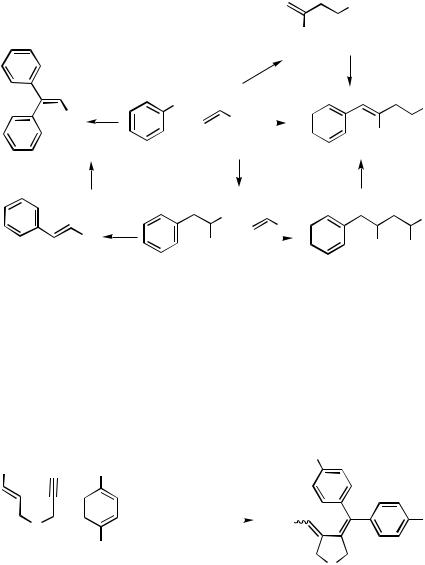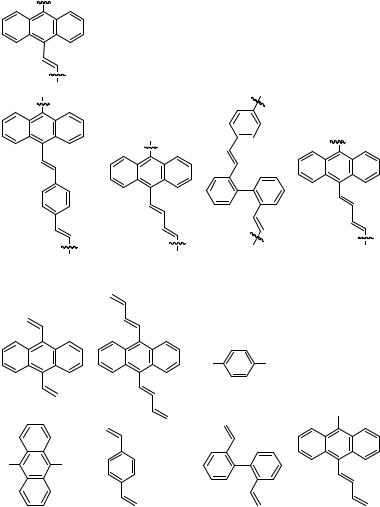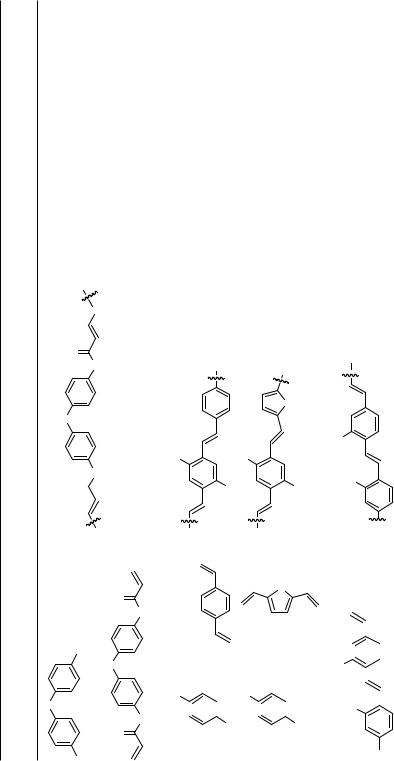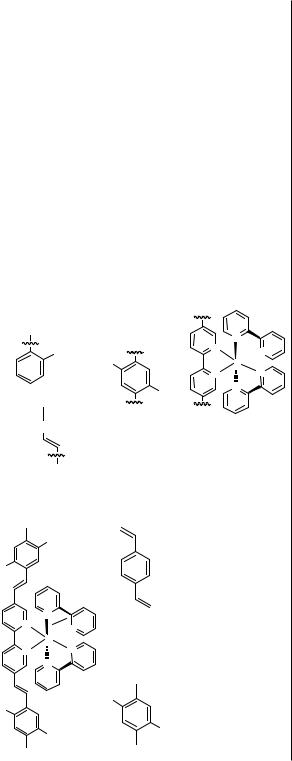

IV.2.1.2 DOUBLE AND MULTIPLE HECK REACTIONS |
1199 |
to eventually—after double shift—yield a diethyl(arylmethylene)glutarate.[65] Alternatively, the acrylate may dimerize first,[69] and the diethyl-2-methyleneglutarate may subsequently undergo a Heck arylation (Scheme 14).
,,
E
E
Pd ,,
E
E
Br |
,, |
Pd |
,, |
|
|
+ |
|
||||
E |
|
|
|
E |
|
|
|
|
|||
|
|
|
|
|
E |
|
|
|
|
|
|
PdX |
E |
|
|
E |
|
E |
|
E |
PdX |
||
|
|||||
|
|
|
|||
|
|
|
|||
Scheme 14 |
|
|
|
|
|
Alkynes may undergo a threefold coupling if suitably substituted. For example, 3- phenylallyl propargyl ether yields an E /Z mixture of 3-diarylmethylene-4-benzylidenete- trahydrofuran, when treated with an aryl halide under Jeffery conditions (Scheme 15).[70] This domino reaction starts with an intermolecular coupling, followed by intramolecular coupling of the intermediate -ethenylpalladium complex and finally a second intermolecular Heck coupling.
|
|
|
|
|
|
|
|
R |
Ph |
|
R |
|
|
|
|
|
|
|
|
|
|
Pd(OAc)2, PPh3 |
|
|
|
|
|
|
|
|
(n-Bu)4NHSO4, DMF, |
|
|||
|
+ |
|
|
80 °C, 15–40 h |
|
|
Ph |
R |
|
O |
|
|
|
||||
|
|
|
||||||
|
|
|
|
|
|
|||
|
|
X |
|
|
|
|
|
|
|
|
|
|
|
|
|
|
O |
|
|
|
X |
R |
% |
|
|
|
|
|
|
|
|
|
|
|
|
|
|
|
I |
H |
46 |
|
|
|
|
|
|
Br |
OMe |
53 |
|
|
|
|
|
|
Br |
NO2 |
36 |
|
|
|
Scheme 15

|
Yield(%) |
(Reference) |
ConjugatedDienes,andTrienes |
|
Product |
HaloarenesandHaloalkeneswithDiethenylarenes, |
Oligo(ethenyl)arene |
Conditions |
13.HeckReactionof |
|
Haloarene |
TABLE |
|
|
|
|
56 |
([71]) |
R
CHO

R
CHO

Br
 R
R
 R
R
|
, |
|
|
|
3 |
|
|
|
CO |
|
|
|
2 |
|
|
, |
NBr,K |
2C,°d |
|
2 |
|
||
Pd(OAc) |
4 |
|
|
Bu |
90 |
|
|
R |
|
t-Bu |
|
|
|
Bu |
I |
|
|
t- |
|
R |
|
= |
|
|
|
R |
|
43 |
([25]) |
N, °C, |
|
Et, |
100, |
3 |
|
2 |
3 |
Pd(OAc) |
P(o-Tol) 17h |
1200

IV.2.1.2 DOUBLE AND MULTIPLE HECK REACTIONS |
1201 |
F. REACTION OF HALOARENES AND HALOALKENES WITH DIETHENYLARENES, CONJUGATED DIENES, AND TRIENES
The multiple arylation of oligoenes was investigated in the early 1980’s by Heck and colleagues. While conjugated dienes such as 1,3-butadiene in the presence of secondary amines with haloarenes yield monoarylated allylamines by nucleophilic substitution on the intermediately formed -allylpalladium complexes, 1, -diaryldienes are formed by twofold coupling. Even 1,3,5-hexatriene can serve as a substrate to give 1,6-diarylsubstituted 1,3,5-hexatrienes (Table 13). In general, electron-withdrawing substituted haloarenes give higher yields (up to 89%) than donor-substituted ones. Similarly, bromoalkenes such as -bromostyrenes can be used. In this case, the reaction with 1,3,5-hexatriene gave a decapentaene derivative, though in low yield. However, this coupling provides an easy access to conjugated oligoene hydrocarbon skeletons.
As by-products, Diels–Alder adducts from the newly formed oligoene reacting as the dienophile and the starting material were observed.
Even the successful twofold coupling of brominated zincatoporphyrins with diethyl octa-2,6-dienoate to give all-carbon tethered bisporphyrins has been reported (Scheme 16).[72] Although the yields were low to moderate, the example demonstrates the feasibility of this coupling methodology for the preparation of highly functionalized molecules.
|
|
|
(EtO2C |
)2 |
|
|
CO2Et |
|
|
|
Br |
|
Pd(OAc)2, LiCl |
|
|
|
|
|
|
|
Bu4NBr, DMF |
|
N |
|
)2 |
|
N |
|
|
|
|
N |
|||
N |
|
|
90 °C, 20–40 h |
|
||||
|
Zn |
|
|
|
|
|
Zn |
|
|
|
29% |
|
|
|
|||
N |
N |
|
|
N |
N |
|
||
|
|
|
|
|
||||
Scheme 16
G. FORMATION OF POLYMERS BY THE REACTION
OF DIHALOARENES WITH DIETHENYLARENES
The Heck reaction has been applied to couple quite a variety of dihaloarenes with different diethenylarenes to give various polyvinylenearylene polymers. In some cases, analogous polymers have been obtained by Heck coupling of -ethenyl- -haloarenes (Table 14)

Conditions (MW) Reference
Yield (%)
toGivePolymers |
Product |
TABLE14.HeckReactionsofOligohaloareneswithOligoethenylarenes |
Oligohaloarene,Oligoethenylarenes |
[73] |
|
|
|
|
|
|
|
|
|
|
|
|
) |
) |
|
) |
|
|
|||
H |
|
4 |
3 |
Zn: |
3 |
|
78 |
|||
73 ×10 |
73 ×10 |
75 10× |
||||||||
: |
|
|
|
|
|
|
|
|
|
|
2 |
|
|
|
|
|
|
|
|
|
|
M= |
3h: |
(4.6 |
3h: (5.3 |
M= |
4h: (8.3 |
4h: |
||||
2 |
3 N,DMF, °C,3–4h |
|
|
|
|
|
|
|
||
, |
, |
|
|
|
|
|
|
|
|
|
Pd(OAc) |
oP(Tol)- |
Bu 100 |
|
|
|
|
|
|
|
|
|
|
3 |
|
|
|
|
|
|
|
|
|
|
|
|
|
|
|
|
|
n |
|
|
|
|
|
|
19 |
|
|
|
|
|
|
|
|
|
|
|
|
|
|
|
|
|
|
|
|
|
|
|
|
|
|
|
|
|
|
|
|
H |
|
|
|
|
|
|
|
|
|
|
9 |
|
|
|
|
|
|
|
|
|
|
OC |
|
|
|
|
|
|
|
|
|
|
|
|
||||
|
|
|
|
|
|
|
|
|
|
|
13 |
|
|
|
H |
|
|
|
6 |
|
|
|
C |
|
|
|
|
N |
N |
|
13 |
|
M |
|
N |
N |
||
H |
|||
6 |
|
|
|
C |
|
|
|
13 |
|
|
H |
|
|
6 |
|
|
C |
|
|
|
N |
19 |
|
M |
H |
13 |
|
9 |
N |
|
OC |
6 |
|
|
H |
|
|
C |
|
I |
I |
|
|
O |
|
|
19 |
|
|
H |
|
|
9 |
|
|
C |
|
) 4
(1.3 × 10
19 H 9 OC
13 H 6 C
13 H 6 C
N N
[74] |
|
|
|
|
2.1−6.4 |
|
|
a |
= |
|
|
b |
|
|
|
n.r. |
DP |
|
|
, |
N, °C, |
−h43 |
|
Pd(OAc) |
PPh |
DMA,100 |
|
2 |
3 |
|
|
|
Et, |
|
|
|
3 |
|
|
n Ar

 Fe
Fe

|
Br |
|
|
|
|
Fe |
|
Br |
O |
|
|
13 |
c |
|
|
I |
|
|
|
H |
|
|
|
6 |
|
|
|
C |
I |
I |
|
|
|
||
|
b |
e |
|
6 |
|
I |
2 |
|
ArX |
||
13 |
|
|
|
H |
I |
|
= |
C |
|
||
|
|
|
^ |
|
I |
|
e |
|
|
|
a– |
a |
O |
d |
I |
||
I |
|
|
1202

[75] |
[76] |
|
|
|
~100 |
3 N,DMF, |
|
|
|
2 |
1C,°d |
|||
, |
, |
|
|
|
Pd(OAc) |
Tol)P(o- Et |
|
90 |
|
|
3 |
|
|
|
|
|
|
|
n |
|
|
|
||
|
|
|
|
|
b
n
a
b
Br |
Br |
units [75] |
|
|
[75] |
[76] |
(Continued) |
15repeat |
perchain |
|
DP=12 |
3 N,DMF, |
|
2 |
3 N,DMF, |
1C,°d |
2 |
1C,°d |
|
, |
, |
|
, |
, |
|
Pd(OAc) |
Tol)P(o- Et |
90 |
Pd(OAc) |
Tol)P(o- Et |
90 |
|
3 |
|
|
3 |
|
 n
n
n 
 n
n
c
c
Br |
Br |
Br
a
1203

Yield (%) (MW) Reference
Conditions
Product
TABLE14. (Continued) |
Oligohaloarene,Oligoethenylarenes |
|
[78] |
|
|
|
−1 |
|
95 |
0.95dLg |
Pd-graphite, |
N,DMF, |
100°C,40h |
Bu |
||
|
3 |
|
|
|
n |
|
|
Ar |
|
O |
|
H
N
O
H
N
O
|
|
O |
|
|
N H |
|
I |
|
|
|
O |
|
2 |
|
O |
ArI |
N H |
|
= |
|
|
^ |
|
|
|
O |
|
I |
|
[79] |
[79] |
62 |
|
|
n.r. |
|
, |
|
|
, |
|
2 |
|
|
2 |
|
) |
DMF, |
12h |
) |
DMF |
(PPh |
(PPh |
|||
3 |
|
|
3 |
|
2 |
N, |
100°C, |
2 |
N, |
PdCl |
Et |
PdCl |
Et |
|
|
3 |
|
|
3 |
n |
n |
|
|
|
S |
25 |
25 |
H |
H |
12 |
12 |
OC |
OC |
O |
O |
25 |
25 |
H |
H |
12 |
12 |
C |
C |
S
25 |
|
|
|
|
25 |
|
|
|
|
H |
|
|
|
|
H |
|
|
|
|
12 |
I |
|
12 |
I |
|
||||
OC |
|
|
|
O |
OC |
|
|
|
O |
|
|
|
|
|
|
||||
|
|
|
|
|
|
|
|
||
|
|
|
|
|
|
|
|
||
|
|
|
|
25 |
|
|
|
|
25 |
|
I |
H |
|
I |
H |
||||
|
|
|
|
12 |
|
|
|
|
12 |
|
|
|
|
C |
|
|
|
|
C |
[77] |
|
|
>95 |
(35,000) |
|
2 |
3 |
DMF |
, |
, |
|
Pd(OAc) |
P(o-Tol) |
Bu |
|
|
N, |
|
|
3 |
 n
n
N |
|
2 |
|
Hex |
2 |
|
NO |
N |
|
|
|
|
|
|
|
|
|
|
|
|
|
|
|
|
|
|
|
|
|
|
|
|
|
|
|
|
|
|
|
|
|
|
2 |
|
|
|
|
Hex |
2 |
|
|
|
|
|
|||
|
NO |
|
||
|
|
|||
Br
1204

[37]
c
2 |
3 |
DMF |
, |
, |
|
Pd(OAc) |
-P(oTol) |
Bu |
|
|
N, |
|
|
3 |
OHex |
OHex |
OHex
Ar
I |
OHex |
|
HexO |
|
|
N |
N |
|
Ru |
N |
|
N |
N |
|
|
N |
|
OHex |
|
OHex |
I |
HexO |
|
|
|
N |
N |
|
|
|
|
|
|
Ru |
N |
|
|
|
|
|
|
and N |
N |
|
|
polymerization/properties, |
|
withAr= |
HexO |
N |
atrandom |
|
|||
I I R= |
RO |
|
|
|
n.r.=notreported. |
Degreeofpolymerization. |
Variousratiosofstartingmaterialsleadtodifferentdegreesof butallpolymerswereobtainedinexcellentyields. |
|
|
|
|
|
a |
b |
c |
1205
1206 |
IV Pd-CATALYZED REACTIONS INVOLVING CARBOPALLADATION |
REFERENCES
[1]R. F. Heck and J. P. Nolley, Jr., J. Org. Chem., 1972, 37, 2320.
[2]U. D. Matsunaga and M. Sumitani, U.S. Patent 3980713 (1976) to Nippon Kayaku K. K., DE 2325302. Chem Abstr., 1974, 80, 84709.
[3]P. Prinz, A. Lansky, T. Haumann, R. Boese, M. Noltemeyer, B. Knieriem, and A. de Meijere,
Angew. Chem. Int. Ed., 1997, 36, 1289.
[4]A. Lansky, Dissertation, Universität Göttingen, 1992.
[5]G. Dyker and A. Thöne, J. Prakt. Chem., 1999, 341, 138.
[6]A. de Meijere, H. Nüske, M. Es-Sayed, T. Labahn, M. Schroen, and S. Bräse, Angew. Chem. Int. Ed. Engl., 1999, 38, 3669.
[7]W. Tao, S. Nesbitt, and R. F. Heck, J. Org. Chem., 1990, 55, 63.
[8]A. Lansky, O. Reiser, and A. de Meijere, Synlett, 1990, 405.
[9]K. Voigt, U. Schick, F. E. Meyer, and A. de Meijere, Synlett, 1994, 189.
[10]A. Diaz-Ortiz, P. Prieto, and E. Vazquez, Synlett, 1997, 269.
[11]K. Voigt, A. Lansky, M. Noltemeyer, and A. de Meijere, Liebigs Ann. Chem., 1996, 899.
[12]S. Bräse, J. Rümper, K. Voigt, S. Albecq, G. Thurau, R. Villard, B. Waegell, and A. de Meijere, Eur. J. Org. Chem., 1998, 671.
[13]J. E. Plevyak and R. F. Heck, J. Org. Chem., 1978, 43, 2454.
[14]K. M. Pietrusiewicz, M. Kuznikowski, and M. Koprowski, Tetrahedron: Asymmetry, 1993, 4, 2143.
[15]A. J. Amoroso, A. M. W. C. Thompson, J. P. Maher, J. A. McCleverty, and M. D. Ward,
Inorg. Chem., 1995, 34, 4828.
[16]B. König, H. Zieg, P. Bubenitschek, and P. G. Jones, Chem. Ber., 1994, 127, 1811.
[17]S. K. Stewart and A. Whiting, J. Organomet. Chem., 1994, 482, 293.
[18]B. König, B. Knieriem, and A. de Meijere, Chem. Ber., 1993, 126, 1643–1650.
[19]G. C. Bazan, W. J. Oldham, R. J. Lachicotte, S. Tretiak, V. Chernyak, and S. Mukamel,
J.Am. Chem. Soc., 1998, 120, 9188.
[20]A. S. Carlstroem and T. Frejd, J. Org. Chem., 1991, 56, 1289.
[21]V. K. Chaikovskii, A. N. Novikov, and T. A. Sarycheva, J. Org. Chem. USSR (Engl. Transl.),
1985, 21, 1783; Zh. Org. Khim., 1985, 21, 1947.
[22]K. N. Dack, R. P. Dickinson, C. J. Long, and J. Steele, Bioorg. Med. Chem. Lett., 1998, 8, 2016.
[23]R. P. Dickinson, K. N. Dack, C. J. Long, and J. Steele, J. Med. Chem., 1997, 40, 3442.
[24]R. Klopsch, S. Koch, and A. D. Schlüter, Eur. J. Org. Chem., 1998, 1275.
[25]T. Mitsudo, W. Fischetti, and R. F. Heck, J. Org. Chem., 1984, 49, 1640.
[26]C.-M. Andersson, J. Larsson, and A. Hallberg, J. Org. Chem., 1990, 55, 5757.
[27]H. A. Staab, J. Weiser, M. Futscher, G. Voigt, A. Rückemann, and C. Anders, Chem. Ber., 1992, 125, 2285.
[28]H. A. Staab, J. Weiser, and E. Baumann, Chem. Ber., 1992, 125, 2275.
[29]H. Detert and E. Sugiono, J. Prakt. Chem. 1999, 341, 358.
[30]N. A. Bumagin, L. I. Sukhomlinova, T. P. Tolstaya, and I. P. Beletskaya, Dokl. Akad. Nauk, 1993, 332, 454.
[31]N. A. Bumagin, V. V. Bykov, L. Sukhomlinova, T. P. Tolstaya, and I. P. Beletskaya,
J.Organomet. Chem., 1995, 486, 259.
[32]M. Takeuchi, T. Tuihij, and J. Nishimura, J. Org. Chem., 1993, 58, 7388.
IV.2.1.2 DOUBLE AND MULTIPLE HECK REACTIONS |
1207 |
[33]K. M. Pietrusiewicz and M. Kuznikowski, Phosphorus, Sulfur Silicon Relat. Elem., 1993, 77, 57.
[34]P. Lorenz, D. Becher, D. Steinborn, E. Poetsch, and B. Akermark, J. Prakt. Chem., 1995, 337, 375.
[35]A. F. Shmidt, T. A. Vladimirova, E. Yu. Shmidt, T. V. Dmitrieva, Izv. Acad. Nauk, Ser. Khim., 1993, 1962, [Russ. Chem. Bull., 1993, 42, 1879 (Engl. Transl.)].
[36]M. Moreno-Manas, M. Perez, and R. Pleixats, Tetrahedron Lett., 1996, 37, 7449.
[37]Z. Peng, A. R. Gharavi, and L. Yu, J. Am. Chem. Soc., 1997, 119, 4622.
[38]K. Y. Kay, Y. G. Baek, D. W. Han, and S. Y. Yeu, Synthesis, 1997, 35.
[39]H. Detert and E. Sugiono, J. Prakt. Chem., 1999, 341, 358.
[40]O. Reiser, S. Reichow, and A. de Meijere, Angew. Chem. Int. Ed. Engl., 1987, 26, 1277.
[41]T. Jeffery, Tetrahedron Lett., 1985, 26, 2667.
[42]T. Jeffery, Tetrahedron, 1996, 52, 10113.
[43]A. J. Amoroso, J. P. Maher, J. A. McCleverty, and M. D. Ward, J. Chem. Soc. Chem. Commun., 1994, 1273.
[44]K. Albrecht, Dissertation, Universität Göttingen, 1993.
[45]J. Rümper, Dissertation, Universität Göttingen, 1993.
[46]H. Meier, N. Hanold, and H. Kalbitz, Synthesis, 1997, 276.
[47]M. W. Majchrzak, J. N. Zobel, D. J. Obradovich, and G. A. Peterson, Org. Prep. Proc. Int., 1997, 29, 361.
[48]S. Sengupta, S. K. Sadhukhan, S. Bhattacharyya, and J. Guha, J. Chem. Soc. Perkin Trans. 1, 1998, 407.
[49]S. Sengupta and S. K. Sadhukhan, Tetrahedron Lett., 1998, 39, 1237.
[50]B. Basu and T. Frejd, Acta Chem. Scand., 1996, 50, 316.
[51]M. Malesevic, G. Karmiski-Zamola, M. Bajic, and D. W. Boykin, Heterocycles, 1995, 41, 2691.
[52]R. Grigg, S. Brown, V. Sridharan, and M. D. Uttley, Tetrahedron Lett., 1998, 39, 3247.
[53]H. Diaz and J. W. Kelly, Tetrahedron Lett., 1991, 32, 5725.
[54]O. Reiser, B. König, K. Meerholz, J. Heinze, T. Wellauer, F. Gerson, R. Frim, M. Rabinovitz, and A. de Meijere, J. Am. Chem. Soc., 1993, 115, 3511.
[55]A. de Meijere and S. Bräse, J. Organomet. Chem., 1999, 576, 88 – 110.
[56]P. V. Zezschwitz, K. Voigt, M. Noltemeyer, A. de Meijere, Synthesis, 2000, 1327. The 1,2- diallenylcyclopentanols, upon deprotonation, did not yield the cyclononenones as reported, but only the 2-substituted 3-alkenylcyclohexanones. R. von Essen, P. V. Zezschwitz, A. de Maijere, unpublished results.
[57]K. Voigt, P. von Zezschwitz, K. Rosauer, A. Lansky, A. Adams, O. Reiser, and A. de Meijere,
Eur. J. Org. Chem., 1998, 1521.
[58]S. Bräse, Synlett, 1999, 1654.
[59]J. Rümper, V. V. Sokolov, K. Rauch, and A. de Meijere, Chem. Ber./Recueil, 1997, 130, 1193.
[60]A. Spencer, J. Organomet. Chem., 1983, 247, 117.
[61]A. Spencer, J. Organomet. Chem., 1983, 258, 101.
[62]L. Li, Z. Zhunangyu, and H. Hongwen, Synth. Commun., 1995, 25, 595.
[63]S. Sengupta, S. Bhattacharyya, and S. K. Sadhukhan, J. Chem. Soc. Perkin Trans. 1, 1998, 275.
[64]R. F. Heck, Acc. Chem. Res., 1979, 12, 146 – 151.
[65]T. Sugihara, M. Takebayashi, and C. Kaneko, Tetrahedron Lett., 1995, 36, 5547.
[66]N. A. Cortese, C. B. Ziegler, Jr., B. J. Hrnjez, and R. F. Heck, J. Org. Chem., 1978, 43, 2952.
[67]S. Cacchi and G. Palmieri, Synthesis, 1984, 575.
1208 |
IV Pd-CATALYZED REACTIONS INVOLVING CARBOPALLADATION |
[68]B. M. Choudary, R. M. Sarma, and K. K. Rao, Tetrahedron, 1992, 48, 719.
[69]S. Bräse, B. Waegell, and A. de Meijere, Synthesis, 1998, 148.
[70]J.-F. Nguefack, V. Bolitt, and D. Sinou, Tetrahedron Lett., 1996, 5527.
[71]S. K. Deb, T. M. Maddux, and L. Yu, J. Am. Chem. Soc., 1997, 119, 9079.
[72]N. Risch, R. Gauler, and R. Keuper, Tetrahedron Lett., 1999, 40, 2925.
[73]Z. Bao, Y. Chen, and L. Yu, Macromolecules, 1994, 27, 4629.
[74]M. Bochmann, J. Lu, and R. D. Cannon, J. Organomet. Chem., 1996, 518, 97.
[75]U. Scherf and K. Müllen, Synthesis, 1992, 23.
[76]H. P. Weitzel and K. Müllen, Makromol. Chem., 1990, 191, 2837.
[77]M. Pan, Z. Bao, and L. Yu, Macromolecules, 1995, 28, 5151.
[78]M. Jikei, Y. Ishida, M.-A. Kakimoto, and Y. Imai, React. Funct. Polym., 1996, 30, 117.
[79]H. Okawa, T. Wada, and H. Sasabe, Synth. Met., 1997, 84, 265.
